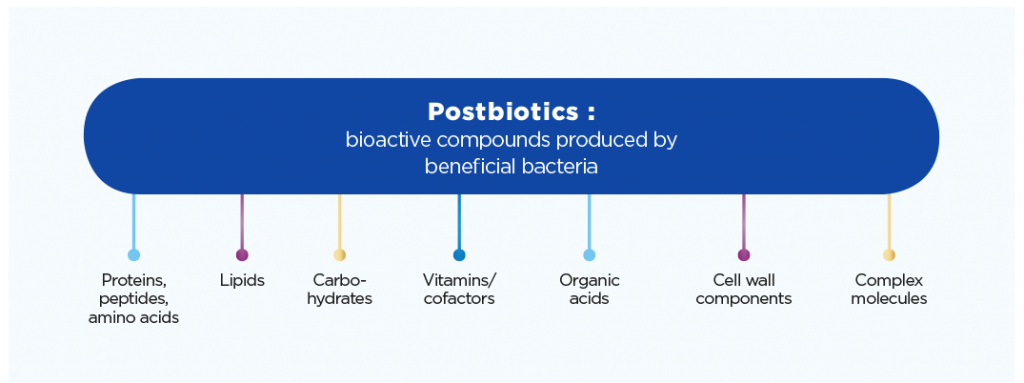Breast milk is an important source of beneficial ‘probiotic’ bacteria that aids the development of a healthy gut microbiota and immune system in babies, essential in the first 1,000 days.
Of the many compounds in human milk, oligosaccharides, bacteria and bioactive compounds produced by bacteria play a key role in the development of a healthy gut microbiota and immune system in newborn babies.
Oligosaccharides in human milk have a ‘prebiotic’ effect
Human milk contains a relatively large number of Human Milk Oligosaccharides (HMOS)1.
HMOS represent the third largest component in milk solids after lactose and lipids2.
More than 200 different oligosaccharides have been identified in breast milk; these have an overall ‘prebiotic’ effect. This means that they pass undigested into the lower part of the baby’s gastrointestinal tract where they promote the growth of beneficial microorganisms, such as bifidobacteria and lactobacilli3. The International Scientific Association for Probiotics and Prebiotics (ISAPP) published the definition for prebiotics in a consensus statement in June 2017, stating that “a prebiotic is a substrate that is selectively utilized by host microorganisms conferring a health benefit.”
The total pool of HMOS as a collective group supports a baby’s immune health in the first 1,000 days; they prevent pathogens from causing infection and increase the number and activity of immune cells to fight against it4.
Bacteria in breast milk
Breast milk contains viable and non-viable bacterial cells and fragments, e.g. Streptococcus, Staphylococcus, Lactobacillus and Bifidobacterium5-7.
There is a high variability in the composition and number of bacteria per millilitre of human milk among mothers and in some cases even within one mother at different points in time8. Moreover, the total number of bacteria in human milk significantly differs according to detection methods. It has been estimated that human milk contains between 103 and 106 bacteria per millilitre8,9. The difference in number could be due to the fact that in molecular-based methods, DNA forms non-viable bacteria and extracellular DNA can be amplified, suggesting not only live bacteria but significant amounts of non-viable bacteria in human milk8.
Although the composition and numbers of bacteria vary widely amongst individuals, human milk is considered to be an important source of beneficial ‘probiotic’ bacteria in the crucial first days and weeks of an infant’s life. The milk microbiome may thus be regarded as an inoculum for the infant’s gut, being essential in programming the immune system to respond appropriately to (food-)antigens, pathogens and commensal bacteria10.
And their metabolite
Interestingly, the immunomodulatory activities of bacteria are also associated with the bioactive compounds produced by these bacteria. Postbiotics refer to these products or by-products secreted by bacteria. During fermentation, bacteria metabolize food and produce various bacterial compounds and metabolites11. Each bacterial strain used during specific fermentation processes produce unique postbiotics and therefore postbiotics from other bacterial strains or produced with another fermentation process cannot be compared.
The various compounds produced as postbiotics are included in the figure below:

Although the importance of postbiotics has been relatively overlooked, increasing scientific evidence points to their beneficial health effects.
References
- Thurl S, Munzert M, Boehm G, Matthews C, Stahl B. Systematic review of the concentrations of oligosaccharides in human milk. Nutr Rev. 2017;75(11):920-933
- Jantscher-Krenn E, Bode L. Human milk oligosaccharides and their potential benefits for the breast-fed neonate. Minerva Pediatr. 2012;64(1):83-99
- Boehm, Gunther, and Bernd Stahl. “Oligosaccharides from milk.” The Journal of nutrition 137.3 (2007): 847S-849S.
- Ayechu-Muruzabal V, van S, Mank M, et al. Diversity of Human Milk Oligosaccharides and Effects on Early Life Immune Development. Front Pediatr. 2018;6:239
- Jost T, Lacroix C, Braegger C, Chassard C. Assessment of bacterial diversity in breast milk using culture-dependent and culture-independent approaches. Br J Nutr. 2013;110(7):1253-1262
- Bergmann H, Rodríguez J, Salminen S, Szajewska H. Probiotics in human milk and probiotic supplementation in infant nutrition: a workshop report. Br J Nutr. 2014;112(7):1119-1128
- Hunt K, Foster J, Forney L, et al. Characterization of the diversity and temporal stability of bacterial communities in human milk. PLoS One. 2011;6(6):e21313
- Boix-Amorós A, Collado M, Mira A. Relationship between Milk Microbiota, Bacterial Load, Macronutrients, and Human Cells during Lactation. Front Microbiol. 2016;7:492
- Heikkilä M, Saris P. Inhibition of Staphylococcus aureus by the commensal bacteria of human milk. J Appl Microbiol. 2003;95(3):471-478
- Martin, Rocio, et al. “Early life: gut microbiota and immune development in infancy.” Beneficial microbes 1.4 (2010): 367-382.
- Aguilar-Toalá JE, Garcia-Varela R, Garcia HS, et al. Postbiotics: An evolving term within the functional foods field. T. 2018;75:105-114. doi:10.1016/j.tifs.2018.03.009
BA19-485
